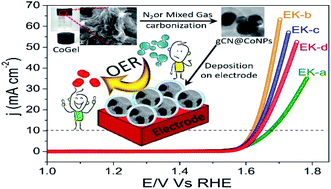Regulating the heteroatom doping in metallogel-derived Co@dual self-doped carbon onions to maximize electrocatalytic water splitting†
Abstract
Despite significant achievements in the synthesis of cobalt-based nanostructured electrocatalysts for water splitting, systematic investigations on the catalyst support, including the regulation of heteroatom doping and its ability to tune the catalytic activity, remain largely unexplored. Herein, we report a series of cobalt nanomaterials encapsulated in N,O-dual self-doped carbon onions, from a cobalt metallogel precursor via a one-step conversion. Homogeneously dispersed cobalt sites encapsulated in porous dual doped carbon onion layers with controllable heteroatom doping proved to be important in maximizing the efficiency for OER in alkaline medium, keeping the cobalt loading constant. Our results revealed that Co@doped carbon onions were a better electrocatalyst as compared to cobalt oxide materials synthesized from the same precursor. The optimal heteroatom-doped cobalt catalyst facilitated OER with a low overpotential of 378 mV at 10 mA cm−2, mass activity of 282.43 mA mg−1 cm−2, and a high turnover frequency (TOF) of 0.012 s−1. The reported materials can be prepared on a large scale and their heteroatom doping can be adjusted easily. These findings would be beneficial in the rational fabrication of transition metal containing electrocatalysts for water splitting.



 Please wait while we load your content...
Please wait while we load your content...